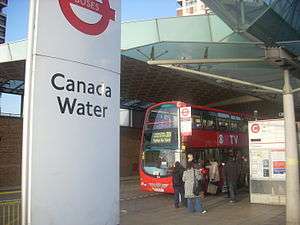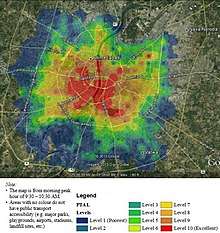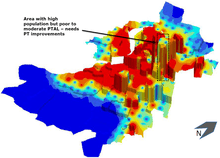Public transport accessibility level
The public transport accessibility level (PTAL) is a method sometimes used in United Kingdom transport planning to assess the access level of geographical areas to public transport.

PTAL is a simple, easily calculated approach that hinges on the distance from any point to the nearest public transport stop, and service frequency at those stops. The result is a grade from 1–6 (including sub-divisions 1a, 1b, 6a and 6b), where a PTAL of 1a indicates extremely poor access to the location by public transport, and a PTAL of 6b indicates excellent access by public transport.
Background
The PTAL calculation was originally developed by the Borough of Hammersmith and Fulham in 1992, and was later adopted by Transport for London in 2004 [1] as the standard method for calculation of public transport access in London. It is not commonly used outside Greater London or the south east of England.
Method
The first stage in PTAL calculation[2] is to calculate the walking distance from the site (known as the point of interest (POI)) to the nearest bus stops and rail stations (where rail can be taken to also include London Underground, DLR and trams). These stops and stations are known as service access points (SAPs). Only SAPs within a certain distance of the POI are included (640m for bus stops and 960m for rail stations, which correspond to a walking time of 8 minutes and 12 minutes respectively at the standard assumed walking speed of 80m/min).
The next stage is to determine the service level during the morning peak (defined as 0815-0915) for each route serving a SAP. Where service levels differ in each direction on a route, the highest frequency is taken. On railways, a route is generally defined as a service with a particular calling pattern – for example, services on the Piccadilly line from Hammersmith could be divided into two "routes": Cockfosters to Heathrow and Cockfosters to Uxbridge.
A total access time for each route is then calculated by adding together the walking time from the POI to the SAP and the average waiting time for services on the route (i.e. half the headway). This is converted to an equivalent doorstep frequency (EDF) by dividing 30 (minutes) by the total access time, which is intended to convert total access time to a "notional average waiting time, as though the route were available at the doorstep of the POI".
A weighting is applied to each route to simulate the enhanced reliability and attractiveness of a route with a higher frequency over other routes. For each mode (e.g. bus, Tube, DLR, tram, rail), the route with the highest frequency is given a weighting of 1.0, with all other routes in that mode weighted at 0.5.
Finally, the EDF and the weighting are multiplied to produce an accessibility index for each route, and the accessibility indices for all routes are summed to produce an overall accessibility index for the POI.
This accessibility index (AI) can then be converted to a PTAL grade (1–6) through a banding system (where AIs 0.00–5.00 are PTAL 1, 5.01–10.00 are PTAL 2, etc. up to PTAL 6 for scores of 25 and above).
TfL introduced the WebCAT automatic calculator in 2015.[3]
Uses
The PTAL is used as a development planning tool in London, to determine both permitted parking standards and development densities. Large site developments (those the London boroughs refer to the Greater London Authority) must follow planning guidelines that allow more parking in areas with low PTALs (i.e., poor public transport) and vice versa—and that also relate the allowed density of development to PTAL (i.e., areas with better public transport may have higher density housing or offices).
TfL also have software to calculate PTALs across wide areas using GIS and timetable data, the typical result being a map with coloured bands relating to PTAL grades.
Application to other countries
Ahmedabad, India

The London PTAL[4] method was first applied in the Indian context to Ahmedabad in 2014 (see figure) by Bhargav Adhvaryu and Jay Shah.[5] PTAL mapping for Surat, Pune and Bangalore are under development. In the London method, points of interest (POIs) were considered by the actual development (e.g., buildings). However, in Ahmedabad, given the lack of availability of building footprint data at the time of the study, the method deviated by construing POIs as centroids of a 1 km2 grid. Given that the purpose of the study was to explore implications of PTAL at a macro-scale (i.e., development/ master plan level – the study area being 465 km2) and the data constraints, the grid-cell approach seemed justified (comparison for which is discussed in the section on Surat application). In addition, it made the computations much faster.
The others adaptation of London method to Ahmedabad included revisiting walk speed and public transport service reliability assumptions. Most of the roads in Ahmedabad do not have footpaths and, if any, are usually occupied by street vendors and parking. Therefore, people are forced to walk on the road (the black-top surface), which creates unsafe and potentially hazardous situations, such that walking is avoided as much as possible, even for short trips. To account for this discomfort walk speed was decreased to 60m/min (based on a few samples) as against 80m/min used in London. The reliability factor added in case of London (to allow for additional wait times) were 2 minutes and 0.75 minutes for buses and rail services, respectively. In Ahmedabad, this was changed to 2.5 minutes for city buses (AMTS) and 1 minute for BRTS (based on empirical observations), and 0.75 minutes was not changed for the proposed metrorail - Ahmedabad Metro (a section of which started operation in March 2019). Lastly, in London 8 minutes (i.e., 640m) and 12 minutes (i.e., 960m) were used as the threshold walk distances to bus and rail SAPs, respectively; SAPs beyond these distances are rejected. However, in Ahmedabad, surveys to determine willingness to walk for public transport were not carried out. Therefore, the farthest SAP from a POI (not accounted for in any other POI) was measured, which turned out to be 993m. At 60m/min, this give as willingness to walk at about 16 minutes, which seemed reasonable.
The Ahmedabad study[5] discussed several uses of PTAL mapping:
- Improving existing public transport systems by recognizing areas with poor accessibility, thereby enabling decision makers to prioritize investments in public transport systems and support non-motorized transport infrastructure.
- Formulating parking policies, e.g. park-and-ride facilities could be provided to supplement areas with low and medium PTAL and parking may be restricted or charged at a higher rate in areas with high PTAL.
- Integrating land use zoning with public transport accessibility. By allowing future transport improvements to be incorporated into PTAL calculations, a future PTAL map becomes an important tool in supporting land use and zoning decisions for local authorities, including introduce transit-oriented development (TOD), as PTALs already incorporate walkability criteria from POIs – an important D (distance to transit) in the 6Ds of TOD. It can also be useful in testing “what if” scenarios using land use - transport interaction models.
- PTAL maps could be used by households to inform their residential location choices, especially low-income households that are captive public transport users. Real estate developers (who supply housing and commercial spaces) could use PTAL maps (both existing and future) for locating potential projects (especially low-income housing and industrial), while government agencies could use PTAL maps to locate social housing projects.
Surat, India

.jpg)
Building from the Ahmedabad case study,[5] PTAL was applied for Surat by Bhargav Adhvaryu, Abhay Chopde, and Lalit Dashora.[6] This application goes beyond the Ahmedabad study in two ways. First, it overlays population density map on PTAL maps (see figure) demonstrating a better way to use PTAL maps to inform public transport investment decisions. Second, it demonstrates the use of PTAL for evaluating future transport investment options. PTAL maps for year 2021 (see figure) were generated based on information on future (and committed) proposals to demonstrate PTAL’s strategic use to create “what-if” scenarios. The Surat study also explicitly justified the use of 1 sq km grid for PTAL mapping in data and resource constrained situation by showing changes in PTAL map resolutions for grid sizes for comparison (see figure). Of course, smaller grid micro-PTAL maps can be prepared for specific areas of the city which could be used to fine-tuning public transport infrastructure provision at local area level.

The Surat study discussed several uses of PTAL mapping such as: [1] prioritising public transport investments [2] Integrating transport in development/master plan [3] informing the parking policy [4] improving residential location choice and optimizing supply of affordable housing, and [5] understanding the mobility needs of the urban poor. The last application is based on another study in Ahmedabad[7] which argues that living in high PTAL areas may not necessarily translate to high accessibility to destination by public transport, especially those urban poor with variable job destination by month and season (e.g., construction workers, casual labourers, street vendors, etc). Superimposing housing location of the urban poor on the PTAL map allows identifying specific areas for enhancing the mobility.
Advantages & disadvantages
Whilst PTAL is a simple calculation (easily performed by a spreadsheet) that offers an obvious indication of the density of public transport provision in an area, it suffers two key problems:
- It does not take into account where services actually go to – for example, a bus that runs every ten minutes to the bottom of the road is considered better than a bus that runs every twelve minutes to the city centre.
- The use of arbitrary cut-offs to exclude more distant service access points underestimates the ability to access locations just outside those cut-off distances. For example, a point 960m from King's Cross could have a PTAL of 6, whilst a point 961m from the same station could have a PTAL of 1 or 2.
Accessibility modelling has been proposed as a solution to these problems. It uses GIS to calculate door-to-door travel times by public transport to a grid of points around the point of interest, resulting in a set of isochrone maps – journey time contours – within which the number of workplaces, households or residents can be calculated using census data. This method takes into account many more factors than PTAL, but is much more time-consuming and requires a level of expertise with GIS software and methodologies.
Similar methods
- Transport for Greater Manchester developed the Greater Manchester Accessibility Level (GMAL) method. This is similar to the PTAL calculation but uses "crow flies" distances to Service Access Points. It also includes an additional score for "Local Link" demand responsive transport services.[8]
References
- FOI https://www.whatdotheyknow.com/request/historical_ptal_public_transport?unfold=1
- London Datastore http://data.london.gov.uk/dataset/public-transport-accessibility-levels/resource/86bbffe1-8af1-49ba-ac9b-b3eacaf68137
- TfL https://tfl.gov.uk/info-for/media/press-releases/2015/april/planners-gain-access-more-data-to-help-plan-more-effectively
- "Measuring Public Transport Accessibility Levels" (PDF).
- Shah, Jay; Adhvaryu, Bhargav (2016). "Public Transport Accessibility Levels for Ahmedabad, India". Journal of Public Transportation. 19 (3): 19–35. doi:10.5038/2375-0901.19.3.2. ISSN 1077-291X.
- Adhvaryu, Bhargav; Chopde, Abhay; Dashora, Lalit (1 June 2019). "Mapping public transport accessibility levels (PTAL) in India and its applications: A case study of Surat". Case Studies on Transport Policy. 7 (2): 293–300. doi:10.1016/j.cstp.2019.03.004. ISSN 2213-624X.
- "Is Public Transport in Ahmedabad Inclusive?". Economic and Political Weekly. 54 (8): 7–8. 5 June 2015.
- Greater Manchester Transportation Unit, http://www.gmtu.gov.uk/gmbusroute/GMAL%20Calculation%20Guide.pdf
External links
- Parking standards in the London Plan, which are linked to PTALs
- Advances in public transport accessibility assessments for development control – a proposed methodology – a paper presented to a PTRC conference proposing an alternative accessibility modelling approach to public transport accessibility calculations
- – TfL PTAL Calculator with map to select point